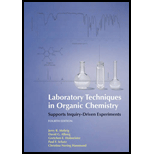
Interpretation:
The decreasing order of the compounds on the basis of ease of elution should be determined.
Concept introduction:
Liquid chromatography is used for purification of high boiling compounds. It is known as column chromatography. In liquid chromatography, column is packed by stationary phase. Usually a solid adsorbent with a liquid coated on it is used as stationary phase. Often a pure liquid or solution of liquids composes the mobile phase. It is also called the elution solvent.
The elution solvent comes down the column in the influence of gravity. Selective interactions are responsible for separation of the sample among stationary and mobile phase. The sequence of elution of compounds from sample depends on the polarity of mobile and stationary phases.
Want to see the full answer?
Check out a sample textbook solution
Chapter 19 Solutions
Laboratory Techniques in Organic Chemistry
- Give the definition of the inductive effect. What is the reason for its appearance in the molecule? Show the effect of the inductive effect in molecules: bromoethane CH3CH3Br; ethanol CH3CH2OH; fluoroethane CH3CH2F.arrow_forwardThe solubility of suberic acid C6H12(COOH)2 is 0.14 g/100 ml H2O and 0.56g/100 ml ethyl ether at 15 0C. Calculate the weight of suberic acid removed from 50 ml aqueous solution containing 40 mg acid by extraction with 50 ml ether. Calculate the weight of acid that would be removed by two successive 25 ml extraction with ether.arrow_forwardA STOCK SOLUTION containing 0.1581 g/L K2CrO4 was prepared.In order to make the CALIBRATION STANDARD, 5 ml of the STOCK was transferredinto a 50ml volumetric flask and then diluted with an appropriate solvent.Calculate:(a) The ppm of K2CrO4 in the CALIBRATION STANDARD.(b) The molarity of K2CrO4 in the CALIBRATION STANDARD. (c) Calculate the molar absorptivity of K2CrO4 (at 371.0 nm). Assume that Beer's Law isobeyed over this concentration range.At 371.0 nm, this CALIBRATION STANDARD in a cell of path length 1.00 cm gave a %T of 59.752.arrow_forward
- Describe in words and by means of complete chemical equations, how a mixture of 1.25 g of benzoic acid tertbutylbenzene can be separated by applying the separation of 2 components by liquid-liquid extraction.arrow_forwardHexanoic acid was added to an immiscible biphasic solvent system, water and CCl4 at 20.0OC and the equilibrium concentrations of hexanoic acid were determined to be 3.66 g/L in H2O and 67.0 g/L in CCl4. Caluclate the distrubution coeffiecent (D2) of hexanoic acid in water with respect to CCl4.arrow_forwardApproximately 6.0mL of concentrated perchloric acid (70%) was transferred to a bottle and diluted with about 1.0L of water. A sample containing 251.5 mg of primary standard Na2B4O7.10H2O required 27.41 mL of the HClO4 solution to reach the methyl red end point. Calculate the molar concentration of the HClO4 (Fwt = 382g/mole)arrow_forward
- Hexanoic acid was added to an immiscible biphasic solvent sysem, water and CCl4 at 20.0OC and the equilibrium concentrations of hexanoic acid were determined to be 3.66 g/L in H2O and 67.0 g/L in CCl4. Caluclate the distrubution coeffiecent (D1) of hexanoic acid in CCl4 with respect to water.arrow_forward4.(a) Aqueous 50.5 % (w/w) sodium hydroxide has a density of 1.53 g cm–3. Calculate the concentration of this solution in mol dm–3. (b) What volume of 50.5 % (w/w) aqueous sodium hydroxide is required to prepare 500 cm3 of 0.100 mol dm–3 stock NaOH? [Start with your answer to 4(a)]arrow_forwardDerive a general expression that shows pH dependence of the distributioncoefficient defined in (2-20) for a weak acid between a fermentation broth and an organic solvent.arrow_forward
- 9. The molar conductivity values at infinite dilution, in units of Sm?mol1, of NHẠCI, NaCl and N2OH are 1.497 x 10², 1.2645 x 10² and 2.478 x 10², respectively. (a) Calculate the molar conductivity at infinite dilution of NH4OH. (b) The molar conductivity of 0.0100 moldm3 NH,OH is 1.13 x 103 Sm?mol. What is the degree of dissociation and the dissociation constant, Kp, of 0.0100 moldm3 NHẠOH?arrow_forwardThe following data give the constant dissociation, K (for acetic acid at various temperatures) T("C) 0 10 15 25 K₂ 1.657 x 10 1.729 x 10 1.745 x 10-5 1.753 x 10 Part A Using the information that InK versus 1/T is a straight line with slope-AH/R. calculate AH for the lonization of acetic acid Express your answer with the appropriate units. AH 2.732 HA kJ mol Submit Previous Answers Request Answer Part B Complete previous panis) ? X Incorrect; Try Again; 4 attempts remaining Review | Constants I Periodic Tablearrow_forwardPenicillin F is recovered from a dilute aqueous fermentation broth by extraction with amyl acetate, using 6.5 volumes of solvent per 100. volumes of the aqueous phase. At pH = 3.8 the distribution coefficient KD is 74. (a) What fraction of the penicillin would be recovered in a single ideal stage? (b) What would be the recovery with three-stage extraction using fresh solvent in both stages? (c) How many ideal stages would be needed to give the same recovery as in part (b) if a counterflow cascade were used with V/L = 0.065?arrow_forward
 Macroscale and Microscale Organic ExperimentsChemistryISBN:9781305577190Author:Kenneth L. Williamson, Katherine M. MastersPublisher:Brooks Cole
Macroscale and Microscale Organic ExperimentsChemistryISBN:9781305577190Author:Kenneth L. Williamson, Katherine M. MastersPublisher:Brooks Cole

